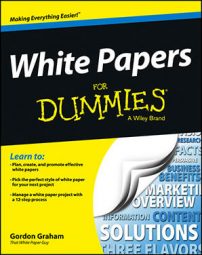Your white paper title is often all that prospects have to go on to make their decision about whether to download or read your white paper. If your title falls flat, they’ll skip right past it. Anything you can do to make your title more compelling to your target audience can have a dramatic effect on your white paper’s success.
Don’t use passive labels in your white paper title
Add some heat to boring titles with active verbs that propel your title up the list of search engine results. Here are two possible improvements, using more active verbs:
“Saving Time and Money with Unattended Scanning”
“Slaying the Paper-Burden Monster with Automated Filing”
Notice how both examples start with a verb gerund that ends in -ing. This tried-and-true format suggests taking action in the present. Don’t project your readers into the future or drag them back to the past with your verb endings.
Avoid weak titles in your white paper
What if your boss or some high-powered reviewer wants to use a title that you think isn’t effective? Will all your hard work come to naught because of a few ill-chosen words on the white paper cover? Thankfully, a simple solution exists: Knock down the weaker title to a subtitle, and insert your more powerful wording as the main title. That way, everyone ends up more or less happy.
Consider the weak title “The Scans Have It.” This title provides no benefit to the reader, no active verbs, no target job title, no connection to much of anything at all. But suppose your VP loves that title, and there’s no talking him out of it. Simply knock that title down to the subtitle and put something far more effective in front of it, perhaps something like this:
“Saving Time and Money with Today’s New Generation of Scanners: The Scans Have It”
If you’re lucky, your target readers will click on your title before they even notice those final words.
Don’t use generic qualifiers in your white paper title
Any number sounds more precise than any qualifier. “I had a temperature of 103” sounds more scientific than “I was burning up from a really bad fever.” See if you can think of some way to work a number into your title.
Of course, if you plan all along to write a numbered list, the title will simply fall into your lap like a gift. If, instead, you find yourself with a boring title and a ho-hum document done in another flavor, you may be able to recast it as a numbered list mash-up.
Think about all the commonplace patterns that occur in everyday life as well as pop culture: three coins in the fountain, four strong winds, five easy pieces, six feet under, seven deadly sins. You may be able to reorganize your white paper around a set of numbers that give it new vigor. Doing so can involve some rewriting, but it can pay off with a much more compelling document.
Consider titles like these:
“4 Little-Known Ways to Save Time with Automated Scanning”
“5 Benefits of Today’s Fifth-Generation Scanners”
Avoid product names in your white paper title
Unless you’re writing a backgrounder to explain the features and benefits of a particular offering, never use a product name in the title of your white paper. Including a product name in a white paper title will cut downloads by 50 percent or more.
Why? Because a product name in the title makes your white paper sound like a sales piece that won’t give B2B buyers the useful information they’re seeking. They’re not ready to evaluate your product; first they want to understand the issue. For a problem/solution flavor, name the problem with the promise of overcoming it, as in the following:
“Slaying the Profit-Sucking Monster of Paper Burden”
What if your VP of Sales insists on including a product name, in the misguided belief that anyone out there cares? If you fight this battle and lose, the best approach is to knock down the product name to a subtitle. Make sure to give the product name right at the end of the subtitle to de-emphasize it:
“Slaying the Profit-Sucking Monster of Paper Burden: A Special Report on the Acme ScanOMatic 3000”
Avoid jargon and buzzwords in your white paper title
Many sales and marketing people love jargon. Although some B2B buyers no doubt Google an occasional buzzword, many more are searching for helpful content about an actual problem they’re facing. Loading up your title with say-nothing buzzwords won’t help your white paper stand out from the crowd. Drop the jargon and find a fresher approach. For example, suppose you find a white paper title that sounds something like this:
“Best-of-Breed Enterprise-Class Automated Filing with Seamless Integration of Fifth-Generation Scanning”
When you cut out the buzzwords, you’re left with these remains:
“Automated Filing with Fifth-Generation Scanning”
That’s actually an okay start for a title. Pump it up with some benefits, the job title you’re aiming at, and an industry problem, and you can transform it into a reasonably effective title:
“Automate Your Filing with Today’s New Generation of Scanners: A Special Report for Insurance Brokers Drowning in Paper”

